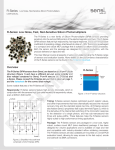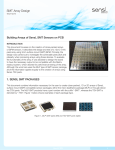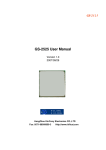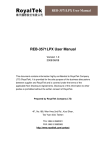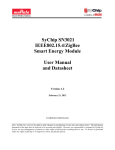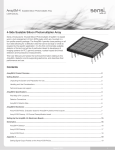Download J-Series user manual
Transcript
J-Series High-Density Fill Factor Silicon Photomultipliers IN A R Y USER MANUAL High-Density Fill Factor Silicon Photomultipliers SensL’s J-Series low-light sensors feature an industry-leading low dark count rate and a high PDE that extends much further into the blue part of the spectrum using a high-volume, P-on-N silicon process. Improvements have been made to both the standard (anode-cathode) rise time and the recovery time, in addition to the inclusion of SensL’s unique fast output that offers sub-nanosecond pulse widths. J-Series sensors are available in different sizes (3mm and 6mm) and use TSV (Through Silicon Via) technology to create a CSP (Chip Scale Package) with minimal deadspace, that is compatible with industry standard, lead-free, reflow soldering processes. The J-Series Silicon Photomultipliers (SiPM) form a range of high gain, single-photon sensitive, UV-to-visible light sensors. They have performance characteristics similar to a conventional PMT, while benefiting from the practical advantages of solid-state technology: low operating voltage, excellent temperature stability, robustness, compactness, output uniformity, and low cost. For more information on the J-Series sensors please refer to the datasheet. Overview M J-Series J-Series SiPM sensors from SensL are based on a P-on-N diode structure (Figure 1), which provides optimized PDE at the blue end of the visible spectrum, and feature a number of significant performance upgrades: P R E LI PDE: J-Series sensors feature increased microcell density, giving an overall improvement to PDE (with a peak at >50%), along with other optimizations that extend the sensitivity into the UV, (>5% PDE at 250nm). This PDE improvement is achieved while keeping the dark count rate <100kHz/mm2. Figure 1, P-on-N sensor structure Timing: J-Series sensors feature reduced microcell recovery time and standard signal rise time. All J-Series sensors also feature SensL’s proprietary fast output terminal (Figure 2), which is the derivative of the internal fast switching of the microcell in response to the detection of a single photon, which has sub-nanosecond rise times and pulse-widths. Package: J-Series sensors are available as either a 3mm or 6mm chip packaged using a TSV (through-silicon via) process to create a CSP (Chip Scale Package) with minimal deadspace. The TSV sensors have a number of ball contacts on the reverse, giving access to the fast output as well as the anode and cathode. Figure 2, Simplified microcell level schematic of the J-Series SiPM. SensL © 2015 1 J-Series High-Density Fill Factor Silicon Photomultipliers USER MANUAL Contents Overview.............................................................................................................................................................1 IN A R Y Biasing and Readout...........................................................................................................................................3 Recommended Biasing................................................................................................................................3 Recommended Readout and Amplification...................................................................................................3 Readout of the Fast Output..........................................................................................................................3 J-Series Mounted Sensors..................................................................................................................................4 MicroFJ-SMA...............................................................................................................................................4 MicroFJ-SMTPA...........................................................................................................................................5 Handling and Soldering.......................................................................................................................................6 Safe Handling of Sensors.............................................................................................................................6 Product Packaging.......................................................................................................................................6 Cleaning.......................................................................................................................................................6 M Solder Reflow Conditions.............................................................................................................................7 Package Drawings (All Dimensions in mm)...........................................................................................................8 MicroFJ-300XX-TSV Package & Solder Footprint.........................................................................................8 LI MicroFJ-60035-TSV Package & Solder Footprint.........................................................................................9 MicroFJ-SMA-60035.................................................................................................................................10 MicroFJ-SMTPA-60035.............................................................................................................................11 R E Further Help......................................................................................................................................................12 P Appendix A - Biasing Alternatives & Signal Polarity............................................................................................13 SensL © 2015 2 USER MANUAL Biasing and Readout Recommended Biasing IN A R Y The cathode needs to be held at a positive bias with respect to the anode, as in Figure 3. It is recommended that bias voltage decoupling, such as the examples shown in Figure 4, is used to provide a stable operating condition. Please refer to the Appendix for further information on biasing schemes and the resulting signal polarities. Figure 3, Recommended biasing Figure 4, Generic biasing set-up with decoupling capacitors. Recommended Readout and Amplification R E LI M Figure 5 shows how the J-Series sensors can be connected to a standard high-speed amplifier, such as the OPA656, to convert the standard output signal current to a voltage. This particular arrangement is suitable for either the 3mm or 6mm sensors. Figure 5, Example circuit for readout of individual sensors. P Y J-Series High-Density Fill Factor Silicon Photomultipliers Readout of the Fast Output For extensive information about the fast output and its readout, please consult pages 4-8 of the C-Series User Manual. In addition, Appendix A of this document shows the resulting signal polarities when various biasing schemes are used. SensL © 2015 3 J-Series High-Density Fill Factor Silicon Photomultipliers USER MANUAL J-Series Mounted Sensors MicroFJ-SMA IN A R Y J-Series sensors are available ready-mounted on test boards, to allow for easy evaluation. The MicroFJ-SMA-XXXXX sensors (Figure 6) feature the TSV-packaged SiPM sensor reflow-soldered onto a small PCB. The board is simple to use, having just three SMA (female) connectors: one delivers the bias voltage (Vbias) and the other two provide the output signals: standard output from the anode (Sout) and the fast output (Fout). The SMA board requires a positive bias, which allows the standard output to be referenced to ground rather than the bias. For the complete circuit schematic, please consult the TSV Board Reference Design document. Bias TSV sensor Fast output Standard output M Mounting holes LI Figure 6, The MicroFJ-SMA-300XX board. Output Vbias Fout Standard female SMA connector R E Sout Connector Function bias input (cathode) Comments positive bias input fast output if unused can be left open standard output (anode) if unused can be left open Table 1, SMA Connections P The MicroFJ-SMA board is for users who require a plug-and-play set-up to quickly evaluate the TSV sensors with optimal timing performance. The board provides outputs which can be connected directly to the oscilloscope or measurement device. The board also allows the standard output from the anode to be observed at the same time as the fast output. Table 1 summarizes the connections to the SMA board. Each board has two mounting holes to allow secure placement during testing. For more discussion regarding the readout of the fast output signals, please consult pages 4-8 of the C-Series User Manual. In addition Appendix A of this document shows the signal output polarities when various biasing schemes are used. SensL © 2015 4 USER MANUAL MicroFJ-SMTPA Pin No. Connection 1 IN A R Y The MicroFJ-SMTPA-XXXXX, or Pin Adapter board (Figure 7), features a TSV-packaged J-Series sensor (type specified by the XXXXX digits) mounted onto a small PCB board. The PCB has five through-hole pins that allow easy electrical connections to the electrodes of the TSV sensor. The pins are labeled on the PCB with numbers 1 - 5. Each of the numbered pins is connected as listed in Table 2, with the option to use either a positive or negative bias. For the complete circuit schematic, please consult the TSV Board Reference Design document. Function Positive bias Negative bias anode standard output (if unused connect to zero V) negative bias input 2 fast fast output (if unused can be left open) fast output (if unused can be left open) 3 cathode positive bias input standard output (if unused connect to zero V) 4 gnd PCB gnd PCB gnd 5 n/c do not connect do not connect M Table 2, Pin assignments for the MicroFC-SMTPA board The does not include any on-board decoupling on the bias line. Therefore, bias decoupling, such as that in Figure 4, should be included on the bias line at the relevant pin (see Table 2). The standard output can be connected directly to an amplifier or 50W load oscilloscope. If the standard output is not used, then that pin should be connected to zero Volts. LI Due to the presence of the pins on the SMTPA board, it is not optimal for evaluation testing where timing with the fast output signal is critical. For evaluations where the timing performance of the fast output is critical, the use of the SMA board is recommended. The connectors from Samtec used are: R E BBL-103-G-E BBL-102-G-E Compatible sockets from Samtec are: SL-103-G-10 SL-102-G-10 Figure 7, The top and bottom of the MicroFJSMTPA-60035 board showing the through-hole pins. P Y J-Series High-Density Fill Factor Silicon Photomultipliers For more discussion regarding the readout of the fast output signals, please consult pages 4-8 of the C-Series User Manual. In addition Appendix A of this document shows the signal output polarities when various biasing schemes are used. SensL © 2015 5 J-Series High-Density Fill Factor Silicon Photomultipliers USER MANUAL Safe Handling of Sensors R Y Handling and Soldering • When unpacking, care should be taken to prevent dropping or misorienting the sensors. The specific items contained in the package and the type of packaging will depend on the parts ordered. • Remember that the SiPM is a sensitive optoelectronic instrument; always handle the sensor as carefully as possible. IN A • The sensor should be disconnected from the bias supply when not in use. • SiPM sensors are ESD sensitive. The following precautions are recommended: • Ensure that personal grounding, environmental controls and work surfaces are compliant with recommendations in JESD625. • Ensure that all personnel handling these devices are trained according to the recommendations in JESD625. • Devices must be placed in an ESD approved carrier during transport through an uncontrolled area. M • Complete handling information can be found in the TSV Handling and Soldering guide. LI Product Packaging E The sensors are shipped in moisture barrier bags (MBBs) according to J-STD 033 standard. An unopened MBB should be stored at a temperature below 40OC and relative humidity <90%. After the MBB has been opened, the devices must be reflow soldered within a period of time depending on the moisture sensitivity level (MSL), which is MSL3. See Table 3 for details. Exposure time Condition 3 168 hours ≤30 °C/60% RH R MSL Table 3, MSL definitions applicable to the J-Series sensors (reference J-STD 020). P Cleaning The parts can be cleaned using Isopropyl alcohol. SensL © 2015 6 USER MANUAL Solder Reflow Conditions IN A R Y The J-Series sensors must be mounted according to specified soldering pad patterns as given on pages 8 and 9. The ‘No Connect’ pins are electrically isolated and should be soldered to a ground (or bias) plane to help with heat dissipation. Solder paste must be evenly applied to each soldering pad to insure proper bonding and positioning of the component. After soldering, allow at least three minutes for the component to cool to room temperature before further operations. Solder reflow conditions must be in compliance with J-STD-20, table 5.2. This is summarized in Figure 8. The number of passes shall not be more than 2. Complete soldering information can be found in the TSV Handling and Soldering guide. Solder Reflow Profile 300 Max 260OC Max 4OC/sec 200 217OC 180OC 150 60~100sec 60 to 120 sec M Temperature (OC) 250 Max 10sec at 260OC 100 50 LI 0 0 50 100 150 200 250 300 Time (sec) R E Figure 8, Reflow solder profile for use with J-Series sensors. P Y J-Series High-Density Fill Factor Silicon Photomultipliers SensL © 2015 7 J-Series High-Density Fill Factor Silicon Photomultipliers USER MANUAL Package Drawings (All Dimensions in mm) M IN A R Y MicroFJ-300XX-TSV Package & Solder Footprint Pin # J-Series B1 Anode B3 Fast Output A1, C3 Cathode All others No Connect * * The ‘No Connect’ pins are electrically isolated and should be soldered to a ground (or bias) plane to help with heat dissipation. P R E LI The complete MicroFJ-300XX-TSV CAD can be downloaded from the website, here. Pin Assignments Solder footprint (all dimensions in mm) SensL © 2015 8 J-Series High-Density Fill Factor Silicon Photomultipliers USER MANUAL R Y LI M IN A Y MicroFJ-60035-TSV Package & Solder Footprint 6.13 MicroFJ-60035-TSV C1, D1 Anode A1, F6 Cathode C6, D6 Fast Output All others No Connect * * The ‘No Connect’ pins are electrically isolated and should be soldered to a ground (or bias) plane to help with heat dissipation. 1 P 0.4 7 6.13 0. 27 R 0.565 E The complete MicroFJ-60035-TSV CAD can be downloaded from the website, here. Ball Assignments Ball # 0.565 1 Solder footprint (all dimensions in mm) SensL © 2015 9 J-Series High-Density Fill Factor Silicon Photomultipliers USER MANUAL R E LI M IN A R Y MicroFJ-SMA-60035 SND0150 MicroFJ-SMA-60035-TSV SND0150 P MicroFJ-SMA-60035-TSV Full CAD schematics are available to download, for both the 3mm and 6mm versions of the SMA board. SensL © 2015 10 J-Series High-Density Fill Factor Silicon Photomultipliers USER MANUAL IN A R Y Y MicroFJ-SMTPA-60035 R E LI M Detector Detector Detector P etector Full CAD schematics are available to download, for both the 3mm and 6mm versions of the SMTPA board. Pin Assignments SensL © 2015 Pin # 1 2 Function Anode Fast Output 11 J-Series High-Density Fill Factor Silicon Photomultipliers USER MANUAL Further Help IN A R Y If more help is required in the set-up or operation of J-Series sensors, there are several SensL resources that can help. • The J-Series Datasheet contains more detailed information on the physical and performance characteristics of the sensors. • A variety of Tech Notes are available on the website, www.sensl.com, such as: •The TSV Handling and Soldering guide. • The TSV Board Reference Design document. • A guide on creating arrays of close-packed sensors. • An extensive library of technical and scientific papers on the use of SensL SiPM sensors. P R E LI M • If additional help is needed, please contact [email protected] www.sensl.com [email protected] +353 21 240 7110 (International) +1 650 641 3278 (North America) All specifications are subject to change without notice Rev. 0.6, Preliminary, November 2015 SensL SensL©©2015 2015 12 USER MANUAL Appendix A - Biasing Alternatives & Signal Polarity Vbias = bias voltage Sout = standard output Fout = fast output Rs = load resistor for the standard output Rf = load resistor for the fast output Vs = standard output voltage Vf = fast output voltage IN A R Y This Appendix lists all of the possible ways in which a J-Series SiPM can be biased. For each biasing arrangement, the standard and fast signal polarities are given. A and B are the recommended configurations. C and D will work, but are not recommended for use with the fast output. The following abbreviations are used throughout: RQ = quench resistor (included on the SiPM die) C1 = decoupling capacitor 10nF (50V), low ESR, ceramic B R E LI M A C D P Y J-Series High-Density Fill Factor Silicon Photomultipliers SensL © 2015 13
















